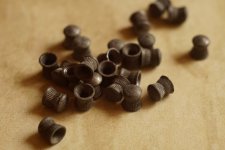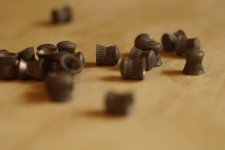- Messages
- 3,692
- Edit My Images
- Yes
O.k so I was looking for some airgun related bits and bobs and came across some extension tubes that I brought a long while ago to give me different focal lengths when using a body cap pin hole lens on one of my film cameras. Yes I got side tracked and had a 15 minute play with them connected to my Sony A6000 and some manual M42 lenses. I tried hand held then I tried with a tripod. Handheld seemed easiest as it was easier to move back and forth to get the items in focus but as the depth of field is so shallow I'm sure the slightest movement would cause problems. My question is when doing this with a tripod would a zoom lens make it easier to zoom in and out to get focus ? I only used a few airgun pellets scattered on the kitchen work top in about a 2 inch group so a lot of them are out of focus but here are my very quick efforts.






